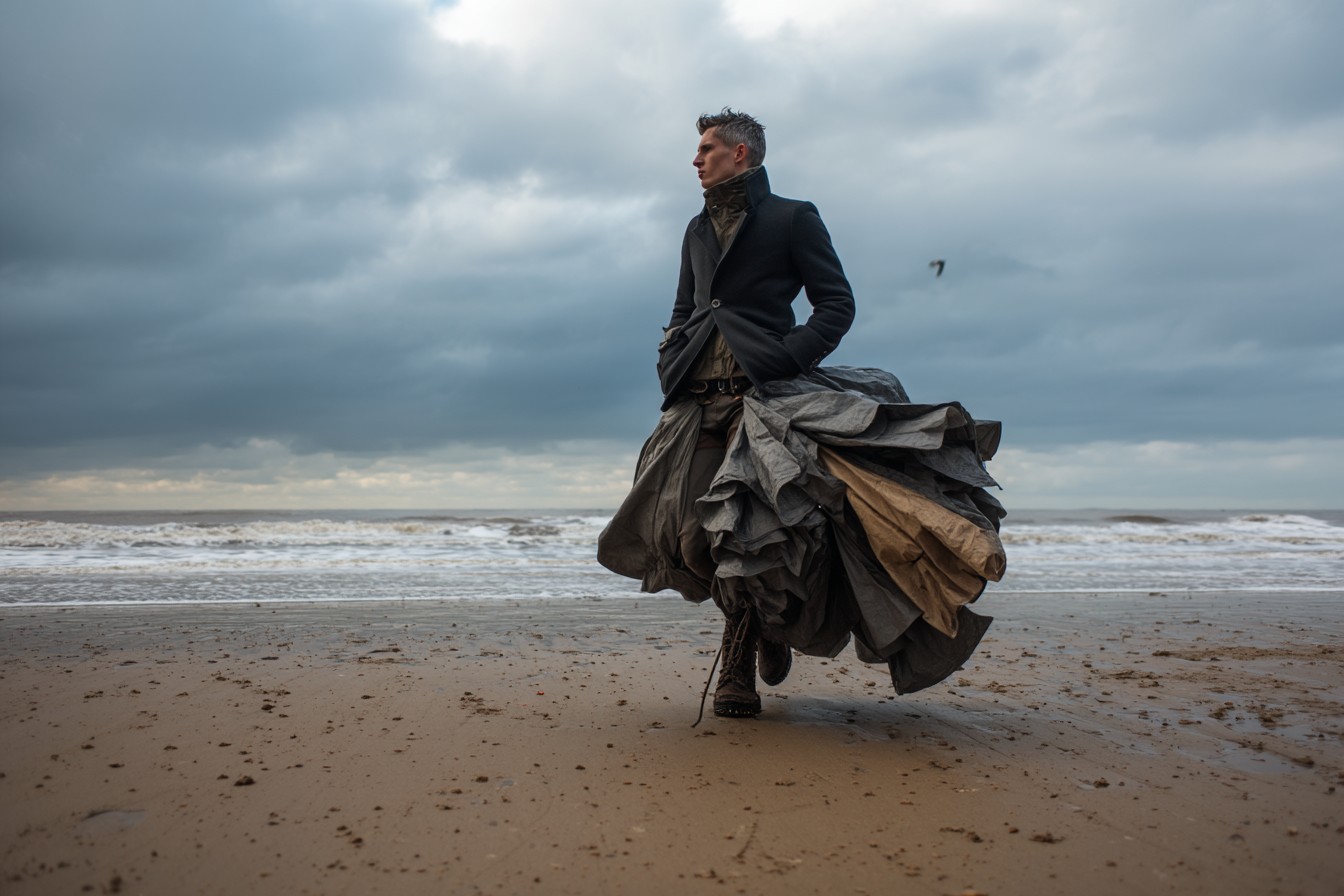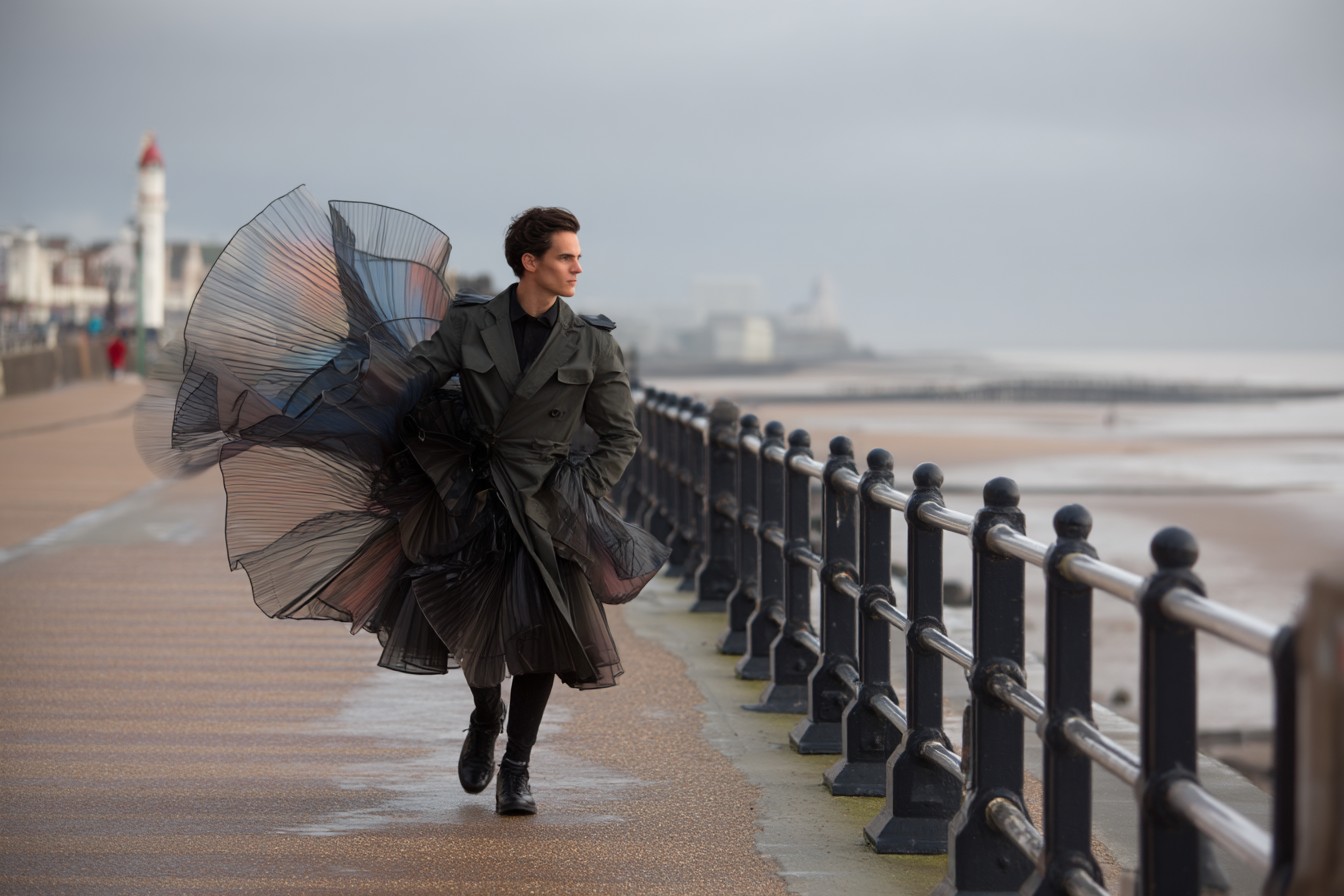I have a slightly embarrassing confession to make. For years, I packed for British seaside holidays as though I was heading to the bloody Amalfi Coast. Linen shirts, lightweight chinos, those preposterously fragile leather sandals that disintegrate if they so much as glimpse saltwater. I’d visualize myself strolling elegantly along some sun-dappled promenade, ice cream in hand, skin taking on that healthy glow that only comes from gentle, consistent sunshine.

The reality, of course, was me huddled behind a windbreak on a Cornish beach, frantically pulling a charity shop sweatshirt over my carefully selected resort wear, while the wind did its level best to exfoliate my face with fine sand. My girlfriend took a photo of me during one such moment in Whitstable three summers ago—sort of hunched over, clutching a takeaway tea with blue-tinged hands, hair arranged by the wind into what looked like some sort of experimental art installation. “For your fashion blog,” she’d said, barely containing her glee at my evident discomfort. Needless to say, that particular image never made it to Instagram.
British seaside holidays require a specific wardrobe strategy that acknowledges the fundamental truth we all know but somehow forget when booking: our coastal weather is, at best, charmingly unpredictable and, at worst, actively hostile to human comfort. That glorious 25-degree heatwave forecasted during your week in Devon? It’ll last precisely 37 minutes on Wednesday afternoon while you’re stuck in a gift shop because someone needed the loo. The rest of the time? Prepare for that peculiarly British meteorological phenomenon—16 degrees and windy, with the persistent threat of drizzle hovering just offshore.
So how do you dress for this reality without completely abandoning all style principles and resorting to the classic British fallback of “hiking gear for all occasions”? After roughly two decades of seaside holidays (and associated wardrobe disasters), I’ve finally cracked a system that keeps me both reasonably comfortable and faintly presentable.

First, let’s talk layers. Not the heavy, winter-appropriate kind, but the light, easily packable, quick-drying variety that can be added or removed as the temperature fluctuates through its typical 10-degree daily range. A decent lightweight merino jumper is worth its weight in gold here. Unlike cotton, it stays warm when damp (critical for unexpected sea spray incidents), doesn’t retain odors when worn repeatedly (important when staying in those charming B&Bs with minimal hanging space), and maintains some semblance of style even when pulled on and off seventeen times in a single afternoon. Uniqlo’s merino options hover around the £30-40 mark and punch well above their weight class performance-wise. John Smedley makes the Rolls Royce version if your budget stretches to £175, but honestly, seaside conditions being what they are, the affordable option might be more sensible.
Under said jumper, forget the classic white t-shirt—it’s a magnet for ice cream drips, seagull contributions, and that mysterious grime that seems to manifest spontaneously in seaside towns. Instead, opt for something with a bit of pattern or texture that can disguise minor mishaps. A Breton stripe is the obvious choice (sailor-inspired clothing actually makes contextual sense here), but a subtle pattern works too. Armor-Lux makes the authentic version, but you’ll find decent alternatives everywhere from M&S to Arket.
For legwear, the great British seaside demands a specific approach. Those lovely linen trousers I mentioned earlier? Save them for Santorini. What you need is something robust enough to withstand sitting on potentially damp sea walls, quick-drying when caught by a rogue wave, comfortable for the surprising amount of walking that seaside towns seem to require, and presentable enough for dinner at that restaurant where you couldn’t get a booking until 9pm. Good quality chinos in a slightly heavier weight than you might typically choose tick all these boxes. The sweet spot is 8-10oz cotton with a bit of stretch—substantial enough to block wind but not so heavy they take days to dry if soaked. Dickies make surprisingly good options that border on workwear but are cut well enough to pass muster in most restaurants.

Footwear is where most seaside sartorial disasters begin. There’s an almost irresistible urge to pack flip-flops or fancy leather sandals, as though sheer optimism might force the weather to accommodate your Caribbean-inspired choices. Resist this impulse. Instead, consider the deck shoe—not the shiny, pristine version beloved by Henley Regatta attendees, but the properly broken-in, salt-stained variety that can handle an impromptu rock pool investigation but still look appropriate for lunch. Sebago and Sperry make the classics (around £100), but if budget is a concern, M&S does a surprisingly decent version for about half that.
For cooler days or evenings, desert boots provide a good compromise between proper shoes and trainers. The crepe sole handles damp pavements and sandy promenades better than leather-soled alternatives, while the ankle height keeps out debris during beach walks. Clark’s Originals remain the benchmark (£120), but Astorflex makes a slightly more refined version if you’re willing to spend a bit more.
The absolute cornerstone of successful British seaside dressing, however, is the right jacket. This single item will make or break your comfort levels and, consequently, your entire holiday experience. What you need is something genuinely windproof (not just wind-resistant—there’s a crucial difference you’ll discover very quickly on a Norfolk beach), reasonably waterproof, breathable enough to prevent that uniquely unpleasant clammy feeling during rare sunny spells, and—crucially—something that doesn’t scream “I’M DOING OUTDOOR ACTIVITIES” at maximum volume.

After years of trial and error, I’ve found that sailing-inspired jackets offer the best combination of functionality and style for seaside conditions. Brands like Henri Lloyd, Musto, and GANT make jackets specifically designed for coastal environments that don’t look like you’re about to attempt a speed-record around Cape Horn. They’re cut slightly longer at the back to protect you when seated on sea walls, feature good quality zips that won’t corrode with the first hint of salt air, and usually include clever details like fleece-lined pockets for hands that have spent too long holding rapidly cooling takeaway coffees.
My personal seaside jacket hero is a navy Henri Lloyd sailing jacket I found on sale four years ago. It’s weathered countless coastal assaults, packs down reasonably small, and looks intentional rather than desperate when worn over most outfits. At around £150-200 full price, these aren’t cheap, but the cost-per-wear over multiple British holidays makes them reasonable value. If that’s beyond your budget, check out French brand Armor-Lux again—their fisherman-inspired jackets offer similar functionality at a gentler price point.
Let’s talk accessories, because they make a disproportionate difference to seaside comfort. A lightweight scarf (yes, even in summer) can transform your microclimate when the wind picks up. Look for cotton/modal blends rather than wool for versatility across temperature ranges. A proper hat is non-negotiable—not just for rare sunny moments but as essential protection against wind that seems determined to extract every last styling product from your hair. Baseball caps blow off; flat caps make you look like you’re cosplaying rural gentry. The ideal is something with adjustable fitting like a bucket hat (they’re legitimately back in style) or a cotton version of a fisherman’s hat with toggles.

Sunglasses are necessary year-round at the British seaside—not always for sun, but as protection against the uniquely exfoliating combination of wind and sand that can make your eyes feel like they’ve been scrubbed with fine sandpaper. Opt for a secure fit over cutting-edge style; this is not the moment for those delicate wireframe numbers that perch precariously on your nose.
A good tote bag completes the seaside kit—something washable, ideally waterproof, with a zip to prevent the wind from making an impromptu inventory check of your possessions. It needs to be substantial enough to accommodate layers shed during unexpected warm spells, but not so heavy it becomes a burden during promenade walks. Canvas is the traditional choice, but modern technical fabrics offer greater protection against damp conditions.
What about those genuinely warm days that occasionally bless our shores? By all means, break out appropriate summer gear—but keep your layering options within reach. The British seaside has an almost supernatural ability to drop ten degrees in temperature when your warm weather outfit commitment is greatest. I’ve learned this lesson repeatedly, most memorably during a July weekend in Margate where the temperature plummeted from 26 to 14 degrees in the time it took to eat a Mr. Whippy.
Perhaps the most important aspect of British seaside style is managing expectations. You’re not in Capri. You’re in Cromer or Cardigan or Croyde, and there’s a distinct charm to embracing that reality rather than fighting it. The British seaside holiday has its own aesthetic—one that involves windswept hair, slightly salt-stiffened clothes, and the particular satisfaction of finding a sheltered spot for coffee while watching horizontal rain lash less prepared visitors.
After years of getting it wrong, I’ve made peace with the fact that my seaside wardrobe is fundamentally different from my Mediterranean one. There’s something liberating about this acceptance—about packing clothes that can handle the reality rather than the fantasy. These days, I actively enjoy the challenge of putting together outfits that can survive a blustery August day in Whitby without resorting to full hiking gear or giving up entirely and buying a novelty waterproof poncho from a gift shop.
The ultimate aim isn’t to look like you’ve stepped from the pages of a summer fashion editorial—it’s to be comfortable enough to actually enjoy your holiday while maintaining some semblance of personal style. And if that means wearing a proper waterproof jacket over your summer outfit while eating ice cream in a force six gale, well, that’s the authentic British seaside experience. Embracing it might be the most stylish move of all.

Leave a Reply